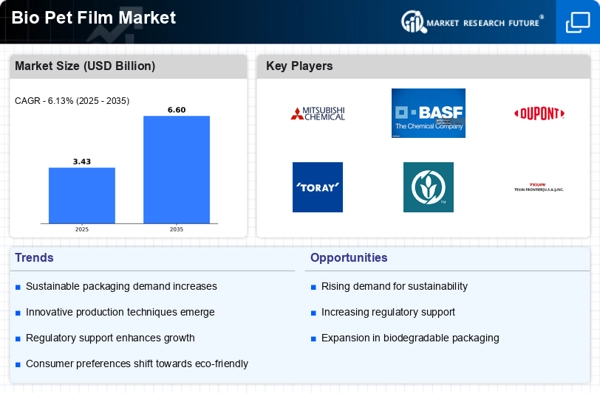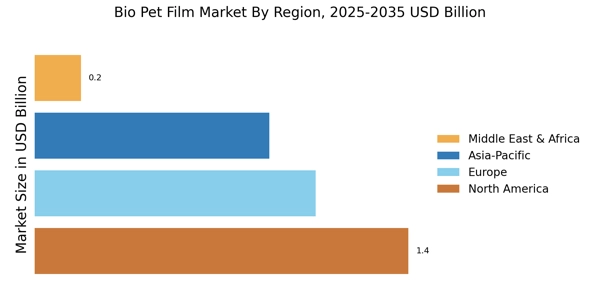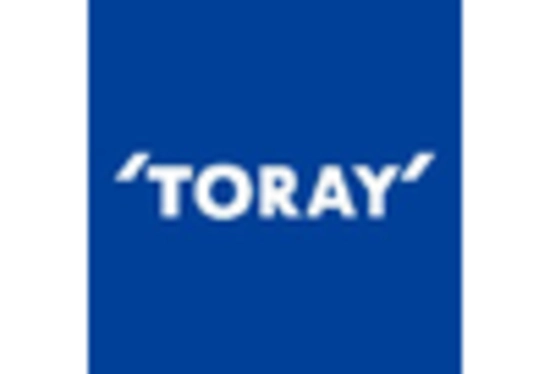Supportive Regulatory Frameworks
The Bio Pet Film Market benefits from a supportive regulatory environment that encourages the use of biodegradable materials. Governments across various regions are implementing policies aimed at reducing plastic waste and promoting sustainable practices. For instance, regulations that mandate the use of eco-friendly packaging in certain sectors are becoming more common. This regulatory support not only incentivizes manufacturers to invest in bio pet films but also creates a favorable market landscape for these products. As compliance with environmental regulations becomes increasingly critical, companies that prioritize bio-based solutions may find themselves at a strategic advantage, positioning themselves as leaders in sustainability.
Growing Applications Across Industries
The versatility of bio pet films is a key driver in the Bio Pet Film Market, as these materials find applications across various sectors, including food packaging, agriculture, and consumer goods. The food packaging segment, in particular, is witnessing a surge in demand for bio-based films due to their ability to extend shelf life while being environmentally friendly. Market data indicates that the food packaging sector accounts for a significant share of the bio pet film market, with expectations of continued growth. Additionally, the agricultural sector is increasingly adopting bio pet films for mulch films and greenhouse covers, further expanding the market's reach. This broad applicability suggests a robust future for bio pet films as industries seek sustainable alternatives.
Rising Demand for Eco-Friendly Packaging
The increasing consumer awareness regarding environmental issues drives the demand for sustainable packaging solutions. In the Bio Pet Film Market, this trend is particularly pronounced as businesses seek alternatives to traditional plastic films. The market for bio-based films is projected to grow significantly, with estimates suggesting a compound annual growth rate of over 10% in the coming years. This shift towards eco-friendly materials is not merely a trend but a fundamental change in consumer preferences, pushing manufacturers to innovate and adopt bio-based solutions. As a result, companies that invest in bio pet films are likely to gain a competitive edge, aligning their products with the values of environmentally conscious consumers.
Consumer Preference for Sustainable Products
Consumer preferences are shifting towards sustainable products, significantly impacting the Bio Pet Film Market. As awareness of environmental issues grows, consumers are increasingly seeking products that align with their values. This trend is evident in the packaging sector, where brands that utilize bio pet films are often perceived more favorably. Market Research Future indicates that a substantial percentage of consumers are willing to pay a premium for eco-friendly packaging solutions. This shift in consumer behavior not only drives demand for bio pet films but also encourages brands to adopt sustainable practices. Consequently, companies that prioritize sustainability in their product offerings are likely to enhance their brand loyalty and market share.
Technological Innovations in Film Production
Advancements in technology play a crucial role in the Bio Pet Film Market. Innovations in production processes, such as improved extrusion techniques and enhanced material formulations, contribute to the development of high-performance bio pet films. These technological improvements not only enhance the physical properties of the films, such as barrier performance and durability, but also reduce production costs. As a result, manufacturers are increasingly able to offer competitive pricing while maintaining quality. The integration of smart technologies, such as IoT in production lines, further streamlines operations, potentially leading to increased efficiency and reduced waste. This technological evolution is likely to attract new players to the market, fostering a more dynamic competitive landscape.


















Leave a Comment